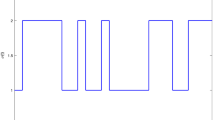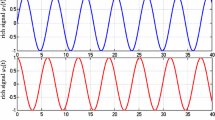Abstract
A switching system always comprises of several subsystems and a rule supervising the switching between the subsystems. A major problem that is often inherent to all dynamical systems is actuator saturation. Saturation is a nonlinear property that nonlinearly maps small input signals to the output, which may affect the system properties and even destroy them. In this study, stability and stabilization of a class of switched stochastic systems with saturation control was investigated. First, the variation parameter method was used to present the integral form of switched stochastic systems. Second, to guarantee that the zero solution is globally exponentially stable in mean square, two sufficient conditions were obtained using direct computation with Gronwall inequality and indirect method with matrix theory, respectively. Further, another simple sufficient condition was obtained for the stability of the systems using the row norm, column norm, and Frobenius norm. Finally, two examples were used to illustrate the preciseness and effectiveness of the results. Moreover, various control designs were observed to stabilize the systems, which differ from the technique of linear matrix inequalities.
Similar content being viewed by others
References
Liberzon D. Switching in Systems and Control. Boston: Birkhäuser, 2003
Sun Z, Ge S S. Switched Linear Systems: Control and Design. Berlin: Springer, 2005
Sun Y G, Wang L. On stability of a class of switched nonlinear systems. Automatica, 2013, 49: 305–307
Zhang J F, Han Z Z, Zhu F B, et al. Absolute exponential stability and stabilization of switched nonlinear systems. Syst Control Lett, 2014, 66: 51–57
Lu X D, Zhang X F. Stability analysis of switched systems on time scales with all modes unstable. Nonlinear Anal-Hybrid Syst, 2019, 33: 371–379
Aleksandrov A Y, Chen Y, Platonov A V, et al. Stability analysis for a class of switched nonlinear systems. Automatica, 2011, 47: 2286–2291
LaSalle J P. The Stability of Dynamical System. Philadelphia: SIAM, 1976
Aleksandrov A, Chen Y, Platonov A, et al. Stability analysis and uniform ultimate boundedness control synthesis for a class of nonlinear switched difference systems. J Differ Equ Appl, 2012, 18: 1545–1561
Zong G D, Wang R H, Zheng W X, et al. Finite-time H∞ control for discrete-time switched nonlinear systems with time delay. Int J Robust Nonlinear Control, 2015, 25: 914–936
Yang D, Zong G D, Karimi H R. H∞ refined antidisturbance control of switched LPV systems with application to aero-engine. IEEE Trans Ind Electron, 2020, 67: 3180–3190
Hou L L, Ren H L, Zong G D. Finite-time stability of interconnected impulsive switched systems. IET Control Theory A, 2016, 46: 648–654
Karatzas I, Shreve S E. Brownian Motion and Stochastic Calculus. 2nd ed. Berlin: Springer, 1991
Mao X R. Stochastic Differential Equations and Applications. Chichester: Horwood Publ, 1997
Guo Y X, Xu C, Wu J. Stability analysis of neutral stochastic delay differential equations by a generalisation of Banach’s contraction principle. Int J Control, 2017, 90: 1555–1560
Guo Y X, Xu C. Controllability of stochastic delay systems with impulse in a separable Hilbert space. Asian J Control, 2016, 18: 779–783
Guo Y X. Globally robust stability analysis for stochastic Cohen-Grossberg neural networks with impulse control and time-varying delays. Ukr Math J, 2018, 69: 1220–1233
Fu X Z, Zhu Q X, Guo Y X. Stabilization of stochastic functional differential systems with delayed impulses. Appl Math Comput, 2019, 346: 776–789
Zhu Q X, Wang H. Output feedback stabilization of stochastic feedforward systems with unknown control coefficients and unknown output function. Automatica, 2018, 87: 166–175
Zhang T, Chen C L P, Chen L, et al. Design of highly nonlinear substitution boxes based on I-Ching operators. IEEE Trans Cybern, 2018, 48: 3349–3358
Zhang T, Wang X H, Xu X M, et al. GCB-Net: graph convolutional broad network and its application in emotion recognition. IEEE Trans Affective Comput, 2019. doi: https://doi.org/10.1109/TAFFC.2019.2937768
Chatterjee D, Liberzon D. Stabilizing randomly switched systems. SIAM J Control Optim, 2011, 49: 2008–2031
Wang B, Zhu Q X. Stability analysis of semi-Markov switched stochastic systems. Automatica, 2018, 94: 72–80
Jiang B P, Kao Y G, Karimi H R, et al. Stability and stabilization for singular switching semi-Markovian jump systems with generally uncertain transition rates. IEEE Trans Autom Control, 2018, 63: 3919–3926
Kao Y G, Yang T S, Park J H. Exponential stability of switched Markovian jumping neutral-type systems with generally incomplete transition rates. Int J Robust Nonlinear Control, 2018, 28: 1583–1596
Kim S H. Stochastic stability and stabilization conditions of semi-Markovian jump systems with mode transition-dependent sojourn-time distributions. Inf Sci, 2017, 385: 314–324
Fang M, Wang L Q, Wu Z G. Asynchronous stabilization of Boolean control networks with stochastic switched signals. IEEE Trans Syst Man Cybern Syst, 2021, 51: 2425–2432
Wang L Q, Fang M, Wu Z G, et al. Necessary and sufficient conditions on pinning stabilization for stochastic Boolean networks. IEEE Trans Cybern, 2020, 50: 4444–4453
Hu T S, Teel A R, Zaccarian L. Anti-windup synthesis for linear control systems with input saturation: achieving regional, nonlinear performance. Automatica, 2008, 44: 512–519
Li Y L, Lin Z L. Stability and Performance of Control Systems with Actuator Saturation. Berlin: Springer, 2018
Liu H P, Boukas E K, Sun F C, et al. Controller design for Markov jumping systems subject to actuator saturation. Automatica, 2006, 42: 459–465
Tarbouriech S, Garcia G, Silva J, et al. Stability and Stabilization of Linear Systems with Saturating Actuators. Berlin: Springer, 2011
Zuo Z Q, Li Y Y, Wang Y J, et al. Event-triggered control for switched systems in the presence of actuator saturation. Int J Syst Sci, 2018, 49: 1478–1490
Duan C, Wu F. Output-feedback control for switched linear systems subject to actuator saturation. Int J Control, 2012, 85: 1532–1545
Benzaouia A, Saydy L, Akhrif O. Stability and control synthesis of switched systems subject to actuator saturation. In: Proceedings of American Control Conference, Boston, 2004
Chen Y G, Wang Z D, Fei S M, et al. Regional stabilization for discrete time-delay systems with actuator saturations via a delay-dependent polytopic approach. IEEE Trans Autom Control, 2019, 64: 1257–1264
Cao Y Y, Lin Z, Shamash Y. Set invariance analysis and gain-scheduling control for LPV systems subject to actuator saturation. Syst Control Lett, 2002, 46: 137–151
Ghosh M K, Goswami A. Risk minimizing option pricing in a semi-Markov modulated market. SIAM J Control Optim, 2009, 48: 1519–1541
Hu Z H, Mu X W. Stabilization for switched stochastic systems with semi-Markovian switching signals and actuator saturation. Inf Sci, 2019, 483: 419–431
Hou Z T, Dong H L, Shi P. Asymptotic stability in the distribution of nonlinear stochastic systems with semi-Markovian switching. ANZIAM J, 2007, 49: 231–241
Li F B, Wu L G, Shi P, et al. State estimation and sliding mode control for semi-Markovian jump systems with mismatched uncertainties. Automatica, 2015, 51: 385–393
Shen Z X, Li C D, Li H F, et al. Estimation of the domain of attraction for discrete-time linear impulsive control systems with input saturation. Appl Math Comput, 2019, 362: 124502
Acknowledgements
This work was supported by Natural Science Foundation of Shandong Province of China (Grant No. ZR2017MA045). The first and the third authors would like to thank the National University of Singapore.
Author information
Authors and Affiliations
Corresponding author
Rights and permissions
About this article
Cite this article
Guo, Y., Ge, S.S., Fu, J. et al. Stability and stabilization of a class of switched stochastic systems with saturation control. Sci. China Inf. Sci. 64, 222201 (2021). https://doi.org/10.1007/s11432-020-3002-7
Received:
Revised:
Accepted:
Published:
DOI: https://doi.org/10.1007/s11432-020-3002-7




